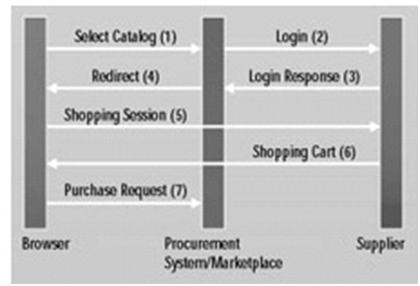Punch-out from WCBE and WCS MPE to External Suppliers
A conventional electronic marketplace (EMP) or a private trading exchange (PTX), such as IBM WCS MPE, provides a variety of trading mechanisms: RFQs, fixed-price buying, auctions, contract-based buying, exchange, and so forth. It also provides support for aggregated catalogs. Both buyers and sellers start by using the catalog to choose a product to buy or to sell. When sellers present products for sale, they identify the method of purchase to be used: RFQ, fixed price, auction, contracted price, or exchange. Buyers must purchase products using the method specified by the seller (with the exclusion of RFQ, which they can initiate).
Aggregating the catalog at the EMP site offers advantages including: it makes a parametric search across suppliers achievable, and it enables small businesses, which do not have the infrastructure to host catalogs, to engage in e-commerce. However, aggregating catalogs has its own boundaries, including:
- It does not protect each supplier's unique brand and Web site design (it requires direct links to the supplier's Web pages).
- It provides limited support for suppliers with very large catalogs.
- It provides no support for product configurations (needed for complex products).
- It supports only static content rather than promoting dynamic, up-to-date information.
- It provides limited support for suppliers with fast changing catalogs or pricing [1].
Thus, in situations in which there is a require for product configurators, or if the catalog contains fast changing prices and products, the suppliers have to sustain catalogs at their own sites and not comprehensive the catalog onto an eMP. In the ordinary EMP approach, a buyer has access to only the sellers who supply in the marketplace with which the buyer is registered. Similarly, a seller cannot sell services and goods in a marketplace dissimilar from the one with which the seller is registered. Now, let's look at a mechanism Called punch-out, in which a buyer in a private marketplace can "punch out" to a remote supplier to buy fixed-price and contract price offerings.
Figure shows the flow for setting up a punch-out process (steps 1 to 7) from a procurement system (or marketplace) to a supplier site; for instance, a WCBE site. Remote suppliers are scheduled at the procurement system. They may offer their entire catalog remotely using punch-out. Otherwise, a supplier may offer a local catalog at the procurement site, with links for particular functions or details. For instance, a supplier may use punch-out for system configuration, or for parts of the supplier catalog that may change commonly. As shown in Figure 1.6, after selecting a remote supplier for primary or further shopping (step 1), a login request (step 2) is sent to the remote supplier as an XML document, encapsulating the user and organization credentials as well as a URL for post back to the procurement system (used at step 7, as shown in Figure1.7). The remote supplier authenticates this request and returns a URL (step 3) with embedded user information. The client's browser is redirected (step 4) to this URL, allowing the buyer to directly shop (step 5) at that remote site using the appropriate catalog for the buyer's organization. At the end of the shopping session, a quote representing the shopping cart is sent back to the client (step 6) and posted back to the procurement system (step 7) at the post back URL referred to previously.

After the purchase request (in XML format) is received back at the procurement system (step 7), it is parsed and added to the buyer's demand. The buyer then submits the demand for approval. After submission, the buyer can then view the submitted requisition and its status, and alter the requisition, if so preferred.
Consequently, the approver views the submitted requisitions and, optionally, may punch out to the supplier to view facts of the requisition. The approver can change the requisition, if so desired. If the approver discards the requisition, the position is so indicated, and can be viewed by the buyer. If the requisition is approved, it is converted into one or more purchase orders (POs), and is sent to the supplier(s). The PO is sent as an XML document, in the format essential by the supplier. If the remote supplier's system is based on WCBE, the PO is formatted in an ordinary canonical format. Also, if it is an Ariba-compliant supplier, it is formatted in cXML. And, if the format is dissimilar, a B2B protocol exchange can be used to convert the PO to the preferred format and protocol. When the remote supplier acknowledges the receipt of the PO, the state of the order at the procurement system is updated. Consequently, additional messages may be sent by the supplier to the procurement system to point out further events, such as issuing an advance shipping notice.